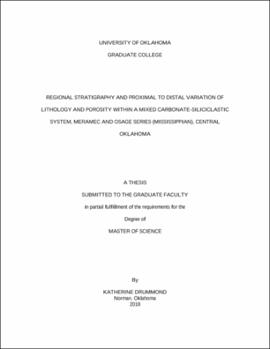| dc.description.abstract | Mississippian reservoirs of northern and central Oklahoma were deposited within a regionally extensive mixed carbonate-siliciclastic system. The stratigraphy, lithology, and porosity characteristics of the Mississippian “Meramec” and “Osage” series vary significantly as older proximal ramp carbonates transition into more distal calcareous, quartz, and feldspar-rich siltstones. Lithofacies within the northern “proximal” area commonly include altered chert, skeletal grainstones, peloidal packstones-grainstones, bioturbated wackestones-packstones, bioturbated mudstones-wackestones, glauconitic sandstones and siliceous shale. Distal lithofacies include structureless to bioturbated calcareous sandstones, calcareous siltstones, and laminated calcareous mudstones. Core-based lithologies are related to well-log properties and predicted in non-cored wells through electrofacies classification methods including Artificial-Neural Network (ANN) and k-means clustering. The ANN yielded the highest overall accuracy (~85%) for classifying lithologies in non-cored wells.
Core data, conventional well logs, lithology logs, and log-attribute curves were integrated to interpret depositional cycles and establish the regional stratigraphic framework of the Mississippian. The Mississippian interval consists of sixteen progradational stratigraphic zones. The proximal to distal and stratigraphic variability of lithology and porosity are evaluated through depositional-dip and oblique-oriented cross sections and reservoir models. From proximal to distal, a carbonate-dominated succession that is capped by diagenetically altered limestone and chert-rich deposits transitions into a more siliciclastic-dominated interval, with increasing clay content stratigraphically upward and basinward. Distally, higher total porosity is associated with greater clay content and less calcite cement. Whereas, proximally, diagenetically altered cherts and cherty limestones exhibit higher total porosity near the crests of clinoforms. | en_US |
